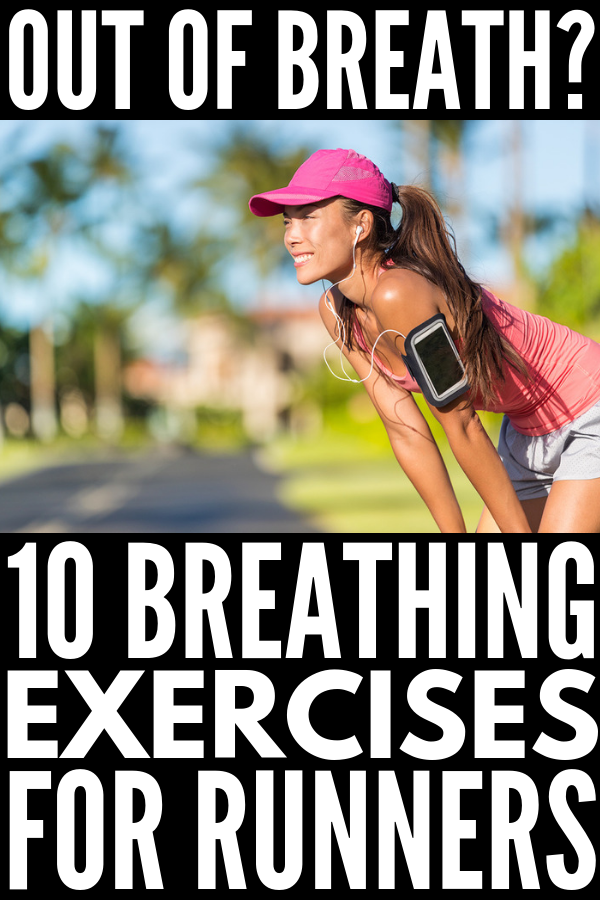
Learning how to breathe while running is one of the most important things you can do as a beginner runner. When I first started running, getting into a good groove with my breathing was a struggle, and without knowing the proper breathing techniques, it made it difficult to run at my fastest, most comfortable pace.
After learning a few breathing exercises for running, it soon became one of my favourite exercises to get my heart rate pumping, and it still is today! If you’re looking for tips on how to properly breathe while you run, here are our best tips and techniques.
3 Breathing Techniques for Runners
1. Deep Belly Breathing
When you’re running, you should always use deep belly breathing (or diaphragmatic breathing) rather than chest breathing. Deep belly breathing is one of the best breathing techniques for running, as it allows for maximal oxygen uptake, while shallow chest breathing can leave you short of breath.
When you breathe with your belly, you use the entire capacity of your lungs and the air is able to stay in the bottom portion of your lungs for a longer period of time. This increases your oxygen uptake, allowing you to breathe easier.
Deep breathing also helps you stay relaxed, which reduces fatigue so you can run for a longer period of time.
2. Combination Breathing
Combination breathing is breathing in and out through your nose and mouth simultaneously. This is what you should be aiming for while you run. Relax your cheeks and part your lips slightly to enhance oxygen intake and outtake.
3. Rhythmic Breathing
Rhythmic breathing is when you create a rhythm between breathing and your running gait (the way in which you run). It describes how many foot strikes you take during the inhale versus the steps you take on the exhale. For example, if you breathe in for three strides and out for three strides, your breathing pattern is 3:3. This is a good goal for beginner runners!
Your exact ratio will depend on a number of factors, including training intensity and personal preferences, so find what works best for you. It can be tough to master at first, but there are plenty of benefits of rhythmic breathing, such as getting more oxygen to your muscles, improving your focus and improving respiratory efficiency.
Mouth Breathing Versus Nose Breathing: What You Need to Know
Mouth breathing versus nose breathing: The great debate. The truth is, you need to breathe through both your nose and mouth when you’re running. Here’s some insight to the importance of both ways of breathing while running.
You may be surprised to hear that our bodies were actually designed for nose breathing. Your nose is part of your respiratory system, ensuring better blood flow and oxygen absorption, so you should focus on breathing through your nose correctly and efficiently.
Since your nose is much smaller than your mouth, when you inhale, it creates greater air pressure and a slower exhalation, giving your lungs extra time to extract a greater amount of oxygen. Your nose has nervous system connections to your lungs and your heart, so if you’re not breathing properly through your nose, it can alter your heart rate and blood pressure. It can also make you more prone to stress.
But you shouldn’t only be focused on nose breathing while you run. Mouth breathing plays a key part in helping you run properly. While you run, your muscles need oxygen, and your nose alone isn’t able to provide enough. You need mouth breathing to take in more oxygen, so make sure you’re breathing through both your mouth and your nose to fulfil your body’s needs while running.
3 Breathing Exercises for Beginning Runners
If you’re looking to practice how to breathe when running as a beginner runner, here are a few exercises you can do.
1. Exercise for Deep Belly Breathing
Lie down on your floor, sofa or bed and place your hands on your stomach. Breathe deeply in and out into your stomach rather than your chest (you should be able to see your hand move up and down). Focus on trying to exhale all the air out of your lungs, and ta da, you’re a deep belly breathing pro!
2. Exercise for Combination Breathing
Once you’ve mastered deep belly breathing, it’s time to move on to combination breathing. To practice this, breathe in and out of your nose and mouth simultaneously throughout the day. Keep in mind, your lips should be slightly parted and your cheeks should be relaxed to allow for maximum oxygen intake and outtake.
3. Exercise for Rhythmic Breathing
As I mentioned above, rhythmic breathing will take some practice, but practice makes perfect as they say. A good rhythmic exercise is to start with walking, and breathe in for three strides and out for three strides if you’re going for the 3:3 breathing pattern. Once you feel comfortable with this pattern walking, you can start jogging.
Take this a little at a time. Try it for 1-2 minutes with focused effort, then take a break, and work up in time as you get more comfortable.
4 Tips to Prevent and Treat a Side Stitch While Running
A side stitch is that stabbing pain below your ribs that sometimes occurs when you’re running. They can be common in beginner runners, so here are some tips to prevent and treat them!
1. Proper Breathing
Focus on your breath while you run. Proper breathing leads to relaxation of the diaphragm and respiratory muscles, and deep breathing and rhythmic breathing can help prevent a side stitch.
2. Take it Easy
If you feel a side stitch coming on, slow down your pace or start walking for a little while. This can help relieve the stitch so you can get back on pace!
3. Use Your Hand
Put pressure on the area with the stitch using your hand. Press down on the painful area while breathing out, and make sure to breathe deeply for best results.
4. Pause and Stretch
If slowing down or walking doesn’t seem to be helping, pause for a moment and do a few small stretching exercises to relieve tension. Try leaning you upper body to each side, stretching deeper with each exhalation.
If you’re new to running, use these breathing tips and techniques to get started on the right foot! Proper breathing can make all the difference for a good run, so make sure to practice the running techniques and exercises and you’ll be on your way!
If you loved this post on how to breathe while running, we’d love if you shared it on Pinterest!

And if you’re looking for more exercise tips and tricks, please follow our Fitness Board on Pinterest!